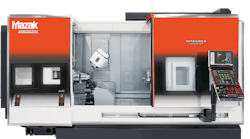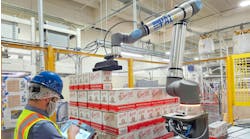Mark Collins is senior automation electrical engineering coordinator at Mazak in Florence, Kentucky. He holds a bachelor of science in electro-mechanical engineering from Miami University in Ohio. With more than 25 years of experience in a variety of roles in the manufacturing and machine tool industry, Collins has acquired a breadth of experience in robotic automation, machining process, industrial networking and security. He is looking forward to seeing how artificial intelligence, big data and the continued move toward a more connected manufacturing industry will affect the future of manufacturing.
As industrial robot installations continue to rise, what innovative or efficient robot-integration applications have you seen or been involved with?
Mark Collins, senior automation electrical engineering coordinator, Mazak: We've been involved in several innovative robot integration applications, including dynamic work cells for real-time adaptive machining, automated inspection and quality control using vision systems and intricate machine-tending scenarios. One notable project included integration of a shop-floor coordinate measuring machine (CMM), an industrial robot and top-of-the-line optical measurement system to provide an automated machining cell with 100% part inspection for a leading supplier in the defense industry.
What have been the biggest improvements to robot integration and interoperability with other robots or components in work cells in the past five years?
Mark Collins, senior automation electrical engineering coordinator, Mazak: Over the past several years, the industry has witnessed significant improvements in standardization and communication protocols. The adoption of open standards such as OPC UA and MTConnect has greatly enhanced interoperability between robots and other components in work cells. Additionally, advancements in Industrial-Internet-of-Things (IIoT) technologies have allowed for seamless data exchange and real-time monitoring, leading to more efficient and synchronized work-cell operations.
Can you explain how software or open-source control architectures have changed robotic integration?
Mark Collins, senior automation electrical engineering coordinator, Mazak: The evolution of software and open-source control architectures has revolutionized robotic integration. Open-source platforms provide greater flexibility, allowing for easier customization and adaptation to specific manufacturing needs. This has led to more streamlined programming, faster implementation and improved collaboration between different robotic systems within a work cell. The use of common software platforms also facilitates smoother communication and integration with other industrial machinery. As the machine-tool industry continues to develop standards like MTConnect to create a normalized semantic vocabulary and information model that doesn’t vary by manufacturer, integration will continue to become easier.
As manufacturers and warehouses/distribution centers push toward autonomous operations, what is the benefit of collaborative robots (cobots) and their ability to work alongside humans?
Mark Collins, senior automation electrical engineering coordinator, Mazak: Collaborative robots, or cobots, play a pivotal role in the move toward autonomous operations. Their inherent safety features and ability to work alongside humans without the need for extensive safety barriers make them ideal for tasks that require close collaboration. This not only enhances operational efficiency, but also contributes to a more flexible and responsive manufacturing environment, where humans and robots can complement each other's strengths. As this technology develops, it will be important for manufacturers to perform in-depth risk assessments to ensure a safe work environment.
When will robotics technology become user-friendly enough that integration, installation and operation are plug-and-play and no longer require extensive engineering?
Mark Collins, senior automation electrical engineering coordinator, Mazak: The industry is progressing rapidly toward more user-friendly solutions. While complete plug-and-play integration might not be achievable in all scenarios due to the complexity of manufacturing processes, we anticipate a significant reduction in engineering efforts within the next decade. Advances in intuitive programming interfaces, standardized communication protocols and modular system designs are key contributors to making robotic technology more accessible and user-friendly.
What future innovations will impact the integration of robotics technology in work cells and with other industrial machinery?
Mark Collins, senior automation electrical engineering coordinator, Mazak: The future of robotic integration will likely be shaped by advancements in artificial intelligence, machine learning and real-time data analytics. Intelligent robotic systems capable of adaptive learning and decision-making will further enhance efficiency and autonomy in work cells. Additionally, the integration of robotics with emerging technologies like augmented reality and digital twins will provide unprecedented levels of control and monitoring, paving the way for highly optimized and interconnected manufacturing ecosystems.
Tell us about your company’s state-of-the-art robotic integration into a work cell or transporting materials/goods between cells.
Mark Collins, senior automation electrical engineering coordinator, Mazak: At Mazak, we've pioneered cutting-edge robotic integration solutions, particularly when incorporated with a Mazak machine tool using the Done In One concept, which incorporates all processes from raw materials input through final machining in just one machine. This can be achieved with a second turning spindle and a milling turret or with a two-spindle, two-turret configuration. Done In One machines offer maximum productivity, reduce production lead times, improve machining accuracy and lower operating expenses. When coupling a Done In One process with a complete custom automation solution, including part measuring with tool-offset feedback and quality inspection, you can increase capacity, flexibility, productivity and profitability and keep your shop competitive on a global basis.






